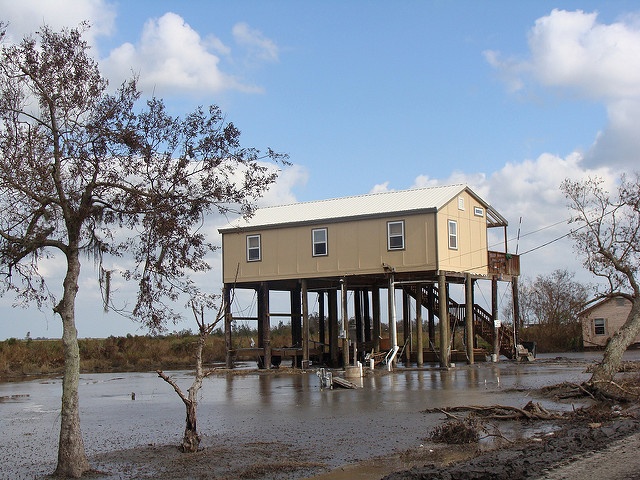Losing its land to the Gulf, Louisiana tribe will resettle with disaster resilience competition award money

The Isle de Jean Charles Band of Biloxi-Chitimacha-Choctaw in South Louisiana watched as their community was gradually swallowed by the Gulf of Mexico. The tribe will use a $48 million grant won as part of a disaster resilience competition to relocate. (Photo by Karen Apricot via Flickr.)
With its South Louisiana homeland sinking into the Gulf of Mexico, the Isle de Jean Charles Band of Biloxi-Chitimacha-Choctaw Indians has announced plans to resettle the chronically flooded community using a $48 million grant won in the National Disaster Resilience Competition (NDRC) a collaboration between the U.S. Department of Housing and Urban Development (HUD) and The Rockefeller Foundation, a private philanthropy.
"This award will allow our Tribe to design and develop a new, culturally appropriate and resilient site for our community, safely located further inland," said Chief Albert Naquin.
Home to the state-recognized tribe since the 1840s, Isle de Jean Charles is located in Louisiana's coastal Terrebonne Parish, an important center of the state's offshore oil and gas industry. As a result of factors related to the industry — land subsidence from drilling, coastal erosion worsened by cuts into wetlands for pipelines and canals, rising seas from global warming — Isle de Jean Charles is slipping into the Gulf, with the tribe losing 98 percent of its land in the past 60 years.
Beset by chronic floods, battered by storms, and with its lone access road periodically underwater as a result, Isle de Jean Charles saw its population decline precipitously in recent years as residents fled to higher ground. The preview for the documentary "Can't Stop the Water" captures the community's plight in heartbreaking detail:
The NDRC grant is going to the tribe in partnership with the Lowlander Center, a nonprofit based in Louisiana's bayous that promotes community-level efforts to address coastal land loss. This is how the tribe's announcement described the collaboration:
The Lowlander Center, along with a team of nationally recognized indigenous and non-indigenous professionals are implementing the resettlement process in partnership with the Tribe. The resettlement will become a living model of community cultural resilience, disaster and climate change mitigation, green building practices, environmental stewardship, and sustainable economic development.
The resettlement will be both "resilient" and "historically-contextual," according to HUD. It will include a health clinic that will serve the tribe as well as the surrounding area, a food market, and an outlet for indigenously-made products. The community hopes to serve as a resource for others around the world facing displacement from rising seas.
New Orleans, Tennessee, Virginia among other competition winners
The NDRC grant funding the tribe's resettlement is part of a larger $92.6 million award won by the state of Louisiana in the competition. The rest of the money will go to support the Louisiana Strategic Adaptations for Future Environments (LA SAFE) Program, which works to protect coastal wetlands around southeast Louisiana, retrofit communities to withstand increased flooding risk, and reshape high-ground areas to maximize their use and safety.
In all, eight states and five cities won awards in the $1 billion competition, ranging from $15 million to help New Jersey address flooding to $176 million for New York City to build a coastal protection system in Lower Manhattan. The top state award of $120 million went to Virginia to support a watershed enhancement project and a center to help businesses respond to climate change.
Five NDRC grant winners are in the South. In addition to Louisiana and Virginia, they are:
* Tennessee, which will get $44.5 million for an initiative to make rural communities along the Mississippi River more resilient to flooding;
* Tennessee's Shelby County, which will receive $60.5 million to to help build a network of green infrastructure projects to increase both resilience to flooding and amenities like trails for area residents; and
* New Orleans, which won $141.3 million to establish its first-ever Resilience District in the Gentilly neighborhood, involving initiatives including coastal restoration, workforce development, and creating parks and green streets — what HUD says will turn the neighborhood "into a national model for retrofitting post-war suburban neighborhoods into resilient, safe and equitable communities of opportunity."
The NDRC is funded through HUD disaster recovery block grants provided by the Disaster Relief Appropriations Act of 2013, which was passed in response to Hurricane Sandy. In a companion effort, The Rockefeller Foundation provided technical assistance to grant applicants and supported a data-based, stakeholder-driven process to identify recovery needs and solutions.
The model for the HUD-Rockefeller NDRC collaboration was Rebuild by Design, a project that used private philanthropic money to involve the world's leading designers and thinkers in considering how to rebuild Sandy-destroyed areas in New York, Connecticut and New Jersey. HUD then awarded $1 billion to applicants using those ideas.
The problem of displacement due to sea-level rise and coastal flooding is expected to worsen in the coming years, with new research warning of dire results if the world fails to cut carbon pollution drastically in the next few decades. In the U.S., sea levels are rising fastest along the Gulf Coast and the East Coast, which is now being considered for offshore oil and gas drilling.
"The people of the Isle de Jean Charles Band of Biloxi-Chitimacha-Choctaw tribe are situated on the front line of Louisiana's coastal land loss disaster and their ancestral home is sinking into the marsh," said Pat Forbes, executive director of the Louisiana Office of Community Development. "This $48 million grant will allow the state to help them resettle their entire community to a safer place with a minimum of disruption to livelihoods and lifestyles. Together, we'll be creating a model for resettlement of endangered coastal communities throughout the United States."
Tags
Sue Sturgis
Sue is the former editorial director of Facing South and the Institute for Southern Studies.
